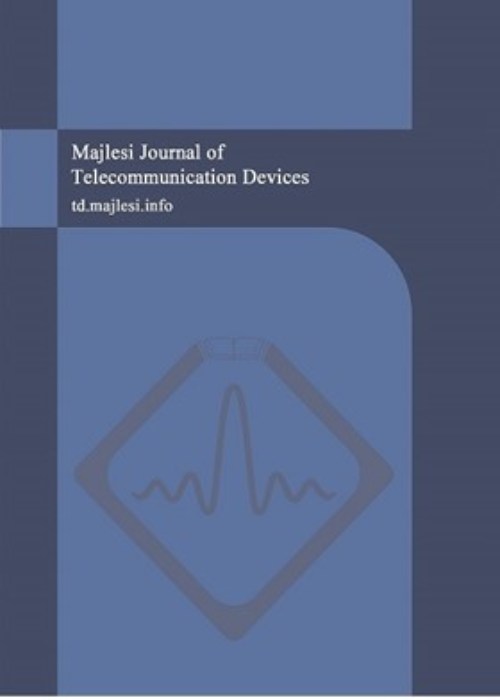فهرست مطالب
Majlesi Journal of Telecommunication Devices
Volume:4 Issue: 1, Mar 2015
- تاریخ انتشار: 1394/02/08
- تعداد عناوین: 6
-
Pages 1-5Due to its nonlinear behavior, operational transconductance amplifier causes substantial distortion in transfer conductance that weakens the intended signal. Analyzing Taylor series, this paper proposes a method to estimate third-order harmonic distortion. As a result, an equation to calculate output current is proposed. Moreover, third-order harmonic distortion is explained in an equation in terms of different parameters. Behavioral simulation was used to investigate harmonic distortion characteristics for the purpose of investigating the validity of the results. Final results show that analytical relationships and the simulation results are perfectly matched.
-
Pages 7-11In this paper, a new design of multiband microstrip U-shaped PIFA antennas is proposed. The antenna has a U-shaped patch on a substrate with dielectric constant of 3 and is shorted to the ground plane through two shorting walls. The antenna operates in three separated frequency bands including 1.16-1.24 GHz, 2.37-2.44 GHz and 3.65-3.75 GHz. That is suitable for wireless frequency bands applications. The first frequency band of antenna is used for wireless video links and wireless video transmitters. The second and third frequency bands are usable for Wi-Fi, Wireless Local Area Network (WLAN) and Bluetooth bands. A slot has been designed on the ground plane to improve radiations at 2.4 GHz and to enhance the bandwidth of the antenna at resonance frequencies
-
Pages 13-16This article presents a Surveillance Multi-Agen System (S-MAS) architecture which focuses on the fusion of data from multi sensors for enhanced automotive safety andtraffic efficiency. In S-MAS tools will be introduced as autonomous agents for implementing a multi-sensor data fusionat architectural level: surveillance–sensor agents, a fusionagent, interface agents, record agents, planning agents, etc.They differ in their ability to carry out a specific surveillancetask. A surveillance–sensor agent controls and manages individual sensors. In this work we focus on the fusion agent, addressing specific problems of on-line sensor alignment, registration, bias removal and data fusion. We show how theinclusion of this fusion agent guarantees that objects of interestare successfully tracked across the whole area.
-
Pages 17-20Since energy is the most fundamental force in human life and the loss and destruction of natural resources will lead to increased costs; tried to use modern electronic methods, such as home automation networks, including wireless sensors are to manage at home, such as remote control, smart energy, security, smart buildings used or to the ability to meet and electrical switches are smart, make the users comfort, lower costs, BEMS needs of their users using the system energy savings are, in order to avoid wasting energy efficiency and move forward.
-
Pages 21-27This paper presents an efficient radio frequency (RF) front-end for power and data telemetry in biomedical implantable devices. The fully integrated system includes an amplitude shift keying (ASK) demodulator, a low drop out (LDO) voltage regulator and a charge pump voltage rectifier. This paper presents a rectifier structure based on Dickson charge pump. Simulation results show that this rectifier can provide 1.4 Voltage supply at a PCE of 33.4%. The rectifier consumes 80µW. The demodulator utilizes an ultra- low power envelope amplifier that removes the need for any voltage comparator or Schmitt trigger circuit, With a carrier frequency of 13.56 MHz and 40 Kbps data rate. The proposed ASK demodulator achieves a modulation index range from 38% consuming less than 32µW. The low drop out regulator can provide a maximum current of 2.8 mA and output voltage of 1.2 V and drop out voltage is 200mV. LDO temperature variation is 2.4µV/˚C. The LDO consumes only about 76µW. Designed in a 0.18 µm CMOS process, the system totally consumes 200µW.
-
Pages 29-35In this paper, a mathematical model is required to describe the nanowires and nanodevices by software is Designing, modeled and implemented. In graphs obtained from the simulation of neural network based on its model reference nano-sensorsm, the current during the reaction and the surface concentration of corresponding tumor cells, identical to the obtained graphs from the test setup, is obtained that based on, a mathematical model based on MATLAB for nanodevices developed and in Designing a nano-bio sensors are used to detect disease. Arrays reference model in this paper consists of 64 nanowire sensor that it, s used to detect prostate cancer. In this paper, a modified method based on principal component analysis (PCA) and neural network design is presented when compared to other existing methods that have almost accuracy 94%, the highest accuracy correctly of 99.28% is capable.


